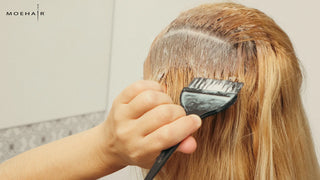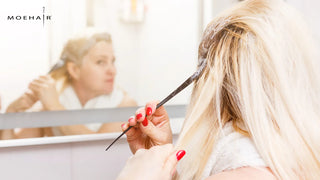 Table of contents
Table of contents
Switching hair color is perhaps the finest way of spicing up your entire look in one go. From sunlit blondes to ash hues, plenty of options already fascinate most of us. Undoubtedly, transitioning from dark to light hair color is a bold yet exciting transformation that is enough to turn heads in envy. Whether you choose blonde shades, sun-kissed highlights, or just lighten your natural hair color, the process requires careful consideration and the right products.
Before following suit, it’s essential to understand how hair lightening works. Dark hair contains a higher concentration of melanin, the pigment responsible for hair color. The process of lightening involves bleaching the hair, which removes the melanin and creates a lighter base. However, bleaching can be harsh on already processed hair, so it is crucial to approach it with professional guidance to avoid any severe damage.
Are you ready to be a showstopper with your luminous light hair? Let’s introduce you to six simple steps of hair lightening.

Step 1 - Preparation
First things first, assess your hair’s health. Bleaching is a chemical process that can be highly damaging, so it’s important to start with hair that’s in good condition. If your tresses are already dry, brittle, or damaged, indulge in deep conditioning treatments a few weeks before beginning the lightening process. You can use nourishing masks like Moehair Luxx Deep Conditioning Mask to restore moisture and strengthen your strands.
Step 2 - Consulting a professional vs. DIY approach
One of the most significant decisions you will make is whether to go to a professional stylist or attempt the process at home. While lightening hair at home can be cost-effective, it is a challenging and risky process that requires skill and knowledge, especially if your hair is naturally dark. If you’re new to hair coloring or want to achieve a specific shade, it’s always best to consult a professional.
Step 3 - Choosing the right shade
Deciding on the shade you want is probably the most overwhelming task ever. Do you want to go platinum blonde, ash blonde, honey blonde, or lighter brunette? Your skin tone plays a crucial role in determining the most flattering shade. Here’s a quick guide for people who can’t wait to transition from dark to light hair color.
- Warm skin tones - Tints like caramel, honey blonde, and golden blonde compliment these skin tones the most.
- Cool skin tones - Ash blonde, platinum blonde, and cool beige shades enhance the natural characteristics of these skin tones.
- Neutral skin tones - You can experiment with a wide range of hair colors on neutral skin tones.
Step 4 - Bleaching
Bleaching is the most critical yet delicate part of this transition from dark to light hair. Here’s how to lighten your tresses effortlessly using bleach.
- Perform a strand test - Before applying bleach to your mane, perform a strand test to see how your hair reacts. Mix a small amount of bleach and developer in a non-metallic bowl and apply it to a hidden section of hair. A strand test helps test the product for allergies and other reactions.
- Prepare the bleach mixture - Use a quality bleach powder like Moehair Tru Blu High Lift Lightener. Mix it with a developer in a 1:1.5 ratio. A low-volume developer is less damaging and ideal for multiple bleaching sessions.
- Section your hair - Divide your hair into manageable sections to ensure even application of the mixture.
- Apply the bleach - Start applying bleach from the ends and work your way up to the roots. The roots process faster due to the heat from your scalp. Apply bleach carefully, ensuring every strand is coated.
- Monitor the process - Check your hair every 10-15 minutes to prevent over-processing. Dark strands may take 30-45 minutes to lift to a lighter shade, whereas roots may only require 10 minutes to process.
- Rinse and condition - Rinse thoroughly with shampoo and water. Apply a deep conditioner to replenish moisture.
Editor’s Tip: To minimize damage, avoid bleaching your hair more than once in one session. Space out bleaching sessions by 3-4 weeks.
Step 5 - Toning your hair
Once you’ve achieved the desired level of lift, your hair will likely have some brassiness or yellow tones. Toning helps neutralize these unwanted hues and create a more harmonious look. Use Moehair Color Infuse Blonde Toner for natural-looking results. Apply and massage a generous amount of hair toner to your strands and evenly distribute along the length. Let it sit for 3 to 5 minutes before rinsing with cold or lukewarm water.
Step 6 - Applying the hair dye
After toning, you can apply your chosen hair dye to achieve the desired shade. Opt for Moehair Permanent Hair Dye, which is infused with keratin and emollients to provide a smooth finish. Follow the instructions on the package and apply the dye to your hair. Let it process for an adequate amount of time, then rinse.
Natural Alternatives for Hair Lightening

Although some beauty blogs may convince you to use natural alternatives to transition from dark to light hair, they may not be as effective as bleach. According to Colorist Rachel Bodt, “When you are working with darker hair, you are dealing with red and orange undertones, and these will be the first colors to be exposed.” So, before giving these DIY options a whirl, consider what results you may achieve. Dark brunettes may turn light brown, and natural blonde hair may look like lighter blondes. Expecting a generous transformation, indulge in natural hair lightening with these safer options.
Lemon juice
It is one of the most effective natural hair lighteners containing citric acid. When applied to the mane, the acid opens up the hair cuticles, breaking down the melanin. Mix the juice of 2-3 lemons with water to avoid excessive drying. Spray or apply the mixture evenly to your hair, then spend 30 minutes to an hour in the sun. Rinse thoroughly and follow up with a conditioner.
Honey and cinnamon
Honey contains a small amount of hydrogen peroxide, a natural lightening agent. Cinnamon boosts this lightening effect as it is loaded with compounds that help activate the peroxide in honey. Mix 2 tablespoons (tbsp) of honey, 1 tbsp of cinnamon, and 1 tbsp of olive oil in a bowl. Apply this mixture to your damp hair strands. Wear a shower cap and leave it on for at least 3 hours or overnight for the best results. Rinse thoroughly and follow up with a hydrating conditioner.
Chamomile tea
Chamomile is known for its natural brightening properties. It is incredibly soothing and gentle on the scalp. It is ideal for those seeking a subtle transformation from dark to light hair without any significant harsh effects. Brew 2-3 chamomile tea bags in boiling water and allow the tea to cool. Pour it over your hair and let it work its magic for 30 minutes. Rinse with water, followed by a conditioner to retain moisture.
Apple cider vinegar
Being acidic in nature, it can help gradually lift the hair color. Mix equal parts of apple cider vinegar and water in a spray bottle. Apply it to your strands and leave it on for 30 minutes. Rinse with cold water and follow with a conditioner. It not only lightens hair color but also balances the scalp’s pH and leaves hair feeling refreshed.
Baking soda and hydrogen peroxide
Baking soda is an exfoliant that removes the outer layer of color from hair. Combined with hydrogen peroxide, a mild bleaching agent, it creates a potent lightening solution. Mix baking soda with a small amount of hydrogen peroxide to form a thick paste. Apply it evenly to your strands and let it process for 20 minutes. Rinse with water and use a conditioner.
Aftercare and Maintenance
By now, you must have realized that bleaching can take a toll on your hair’s health. Thus, it becomes crucial to invest in a proper aftercare routine. Tapping expert colorists from all over, we’ve come up with the following tips. Take our Hair Quiz for personalized product recommendations, and maintain your flawless hues for longer.
- Deep conditioning - Using an ultra-hydrating deep conditioner is as essential as clicking thousands of pictures after a major hair transformation. Opt for Moehair Luxx Violet Deep Conditioning Mask to rejuvenate lackluster hair and revive natural texture. Its violet pigments help neutralize brassy tones, offering a natural-looking finish.
- Goodbye, sulfates! - Choose hair products that are free of sulfates and other harsh chemicals. Sulfates can strip hair of natural oils and moisture, severely affecting its color. Invest in a pigmented shampoo like Moehair Color Vibrant Blonde Shampoo for warm hues or Color Vibrant Silver Shampoo for cool shades.
- Bonding treatment - The transition from dark to light hair can leave your hair dull and frizzy due to chemical exposure. Restore hydration and shine with hair bonding treatment. It helps reconstruct the mane’s internal structure and strengthens each strand from deep within.
- Root touch-up and toning - Your light hair may require frequent root touch-ups, preferably in the salon. This helps cover gray areas and tone down unwanted tones. You can also use a hair toner at home to maintain vibrant hues between salon appointments.
- Skip heat styling - Tools like hair straighteners, curling irons, and blow dryers can contribute to color fading. It is recommended to ditch heat styling tools and go for mindful options.
FAQs
Q1. How can you go from dark to light hair?
Hair lighteners and toners are specifically designed to lighten dark hair color. However, these are salon-grade products that must not be used without professional guidance.
Q2. Does lemon juice lighten hair color?
Yes, lemon juice does lighten hair color, but it can be dangerous when over-processed. It is highly acidic and can burn your strands.
Q3. How to reduce damage caused by bleach?
Mix Moeplex Bond with bleach and developer to minimize damage, and follow up with Moeplex Seal for a smooth, hydrating effect.
Q4. Does light hair color make you look younger?
Light hair color softens your facial features and makes wrinkles less noticeable, thus providing a more youthful look.
References
https://www.teenvogue.com/story/how-to-lighten-hair-with-the-sunhttps://www.aad.org/public/everyday-care/hair-scalp-care/hair/coloring-perming-tips
https://my.clevelandclinic.org/health/body/22615-melanin
How we reviewed this article:
Our experts continually monitor the fashion and beauty space, and we update our articles when new information becomes available.
-
Current Version
-
Oct 25, 2024
Written By -
Upasana Kakati is a lifestyle writer with 7+ years of experience in writing in the beauty and haircare industry.
Edited By -
Saima Ahmed with 8+ yrs of experience, specializes in crafting engaging content focused on Hair care, lifestyle, and beauty.






















